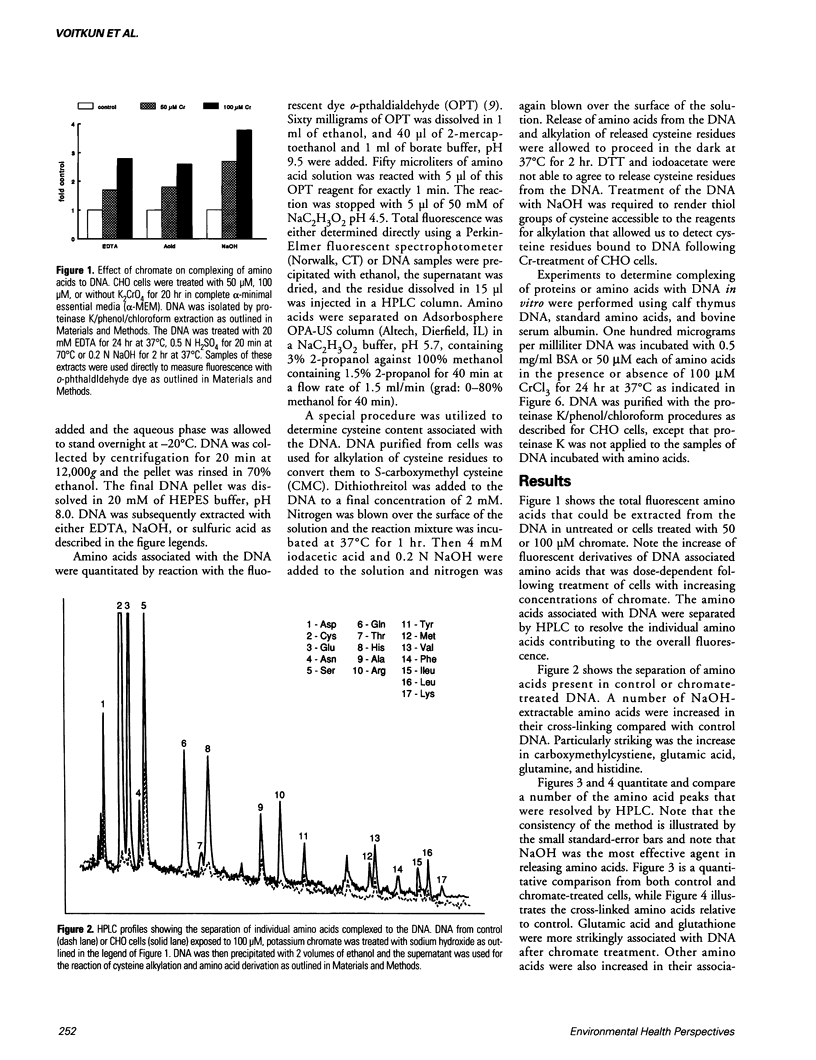Abstract
Using o-pthaldialdehyde (OPT) fluorescence, the amino acids associated with DNA were studied following exposure of intact Chinese hamster ovary cells to chromate. Rigorous extraction with EDTA, acid, or base was required to release the amino acids cross-linked to the DNA isolated from control or chromate-treated cells by standard procedures (i.e., proteinase K, phenol, etc.). Amino acids resisting extraction from DNA were not studied since analysis was limited to those that could be released by these procedures. There was a chromate dose-dependent increase in amino acids complexed with the DNA that could be released by EDTA, acid, and base, and these amino acids were separated by HPLC and identified. Substantial increases in cysteine, glutamine, glutamic acid, histidine, threonine, and tyrosine were found as a function of increasing concentrations of chromate. There was also a time-dependent increase in complexing of these amino acids to the DNA by chromate. The amino acids found complexed to DNA in intact cells by chromate were thought to originate from reactions of free amino acids or small peptides with the DNA rather than being proteolytic products derived from larger proteins that were cross-linked to the DNA. This was supported by a number of experiments: a) free amino acids or bovine serum albumin (BSA) were cross-linked by chromium to DNA in vitro and the DNA was isolated by standard procedures.(ABSTRACT TRUNCATED AT 250 WORDS)
Full text
PDF




Selected References
These references are in PubMed. This may not be the complete list of references from this article.
- Costa M. Analysis of DNA-protein complexes induced by chemical carcinogens. J Cell Biochem. 1990 Nov;44(3):127–135. doi: 10.1002/jcb.240440302. [DOI] [PubMed] [Google Scholar]
- Costa M., Zhitkovich A., Toniolo P. DNA-protein cross-links in welders: molecular implications. Cancer Res. 1993 Feb 1;53(3):460–463. [PubMed] [Google Scholar]
- Gianfranceschi G. L., Barra D., Bossa F., Coderoni S., Paparelli M., Venanzi F., Cicconi F., Amici D. Small peptides controlling transcription in vitro are bound to chromatin DNA. Biochim Biophys Acta. 1982 Nov 30;699(2):138–148. doi: 10.1016/0167-4781(82)90147-6. [DOI] [PubMed] [Google Scholar]
- Juodka B., Pfütz M., Werner D. Chemical and enzymatic analysis of covalent bonds between peptides and chromosomal DNA. Nucleic Acids Res. 1991 Dec 11;19(23):6391–6398. doi: 10.1093/nar/19.23.6391. [DOI] [PMC free article] [PubMed] [Google Scholar]
- Lin X., Zhuang Z., Costa M. Analysis of residual amino acid--DNA crosslinks induced in intact cells by nickel and chromium compounds. Carcinogenesis. 1992 Oct;13(10):1763–1768. doi: 10.1093/carcin/13.10.1763. [DOI] [PubMed] [Google Scholar]
- Miller C. A., 3rd, Costa M. Analysis of proteins cross-linked to DNA after treatment of cells with formaldehyde, chromate, and cis-diamminedichloroplatinum(II). Mol Toxicol. 1989 Winter;2(1):11–26. [PubMed] [Google Scholar]
- Neuer B., Plagens U., Werner D. Phosphodiester bonds between polypeptides and chromosomal DNA. J Mol Biol. 1983 Feb 25;164(2):213–235. doi: 10.1016/0022-2836(83)90076-1. [DOI] [PubMed] [Google Scholar]
- Salnikow K., Zhitkovich A., Costa M. Analysis of the binding sites of chromium to DNA and protein in vitro and in intact cells. Carcinogenesis. 1992 Dec;13(12):2341–2346. doi: 10.1093/carcin/13.12.2341. [DOI] [PubMed] [Google Scholar]
- Sutcliffe J. A., Gootz T. D., Barrett J. F. Biochemical characteristics and physiological significance of major DNA topoisomerases. Antimicrob Agents Chemother. 1989 Dec;33(12):2027–2033. doi: 10.1128/aac.33.12.2027. [DOI] [PMC free article] [PubMed] [Google Scholar]
- Zhitkovich A., Costa M. A simple, sensitive assay to detect DNA-protein crosslinks in intact cells and in vivo. Carcinogenesis. 1992 Aug;13(8):1485–1489. doi: 10.1093/carcin/13.8.1485. [DOI] [PubMed] [Google Scholar]


